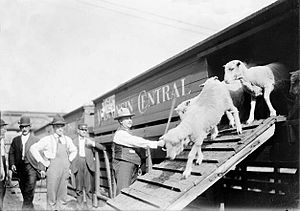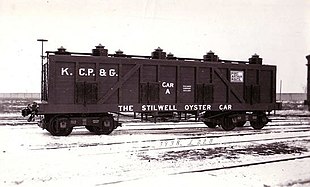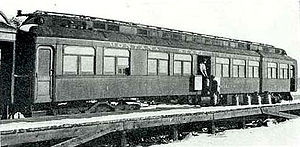Difference between revisions of "AY Honors/Model Railroad/Answer Key"
| (One intermediate revision by the same user not shown) | |||
| Line 4: | Line 4: | ||
==Initial use and development== | ==Initial use and development== | ||
| − | Rail cars | + | Rail cars have been used to transport livestock since the [[1830s]]. The first shipments in the United States were made via the [[Baltimore and Ohio Railroad|B&O Railroad]] in general purpose, open-topped cars with semi-open sides. Thereafter, and until [[1860]], the majority of shipments were made in conventional [[boxcar]]s that had been fitted with open (iron-barred) doors for ventilation. Some railroads constructed "combination" cars that could be utilized for carrying both live animals as well as conventional freight loads. |
[[Image:Santa Fe stock car train rev.jpg|thumb|right|300px|Stock cars make up part of an eastbound [[Atchison, Topeka and Santa Fe Railway|Santa Fe]] freight train in [[March]], [[1943]].]] | [[Image:Santa Fe stock car train rev.jpg|thumb|right|300px|Stock cars make up part of an eastbound [[Atchison, Topeka and Santa Fe Railway|Santa Fe]] freight train in [[March]], [[1943]].]] | ||
| Line 84: | Line 84: | ||
The first all-[[steel]] fish car was built in [[1916]]. Fish car technology improved again in the early [[1920s]] as the milk cans that had been used were replaced by newer tanks, known as "Fearnow" pails. The new tanks were about 5 [[pound]]s (2.3 [[kilogram|kg]]) lighter than the milk cans and included integrated containers for ice and aeration fittings. One 81-[[foot (unit of length)|foot]] (26.7 [[metre]]) long car, built in [[1929]], included its own electrical generator and had enough capacity to carry 500,000 young fish up to 1 [[inch]] (2.54 [[centimetre|cm]]) long. Fish car use declined in the [[1930s]] as fish transportation shifted to a speedier means of transport by air, and to trucks as vehicle technology advanced and road conditions improved. The US government operated only three fish cars in [[1940]], with the last of this fleet taken out of service in [[1947]]. | The first all-[[steel]] fish car was built in [[1916]]. Fish car technology improved again in the early [[1920s]] as the milk cans that had been used were replaced by newer tanks, known as "Fearnow" pails. The new tanks were about 5 [[pound]]s (2.3 [[kilogram|kg]]) lighter than the milk cans and included integrated containers for ice and aeration fittings. One 81-[[foot (unit of length)|foot]] (26.7 [[metre]]) long car, built in [[1929]], included its own electrical generator and had enough capacity to carry 500,000 young fish up to 1 [[inch]] (2.54 [[centimetre|cm]]) long. Fish car use declined in the [[1930s]] as fish transportation shifted to a speedier means of transport by air, and to trucks as vehicle technology advanced and road conditions improved. The US government operated only three fish cars in [[1940]], with the last of this fleet taken out of service in [[1947]]. | ||
| − | In [[1960]], [http://www.midcontinent.org/collectn/woodpas/wfc2.html Wisconsin Fish Commission "Badger Car #2"] was sold to the [[Mid-Continent Railway Historical Society]], where it was restored and is today a part of the Society's collection of historic rolling stock. | + | In [[1960]], [http://www.midcontinent.org/collectn/woodpas/wfc2.html Wisconsin Fish Commission "Badger Car #2"] was sold to the [[Mid-Continent Railway Museum|Mid-Continent Railway Historical Society]], where it was restored and is today a part of the Society's collection of historic rolling stock. |
===Circus use=== | ===Circus use=== | ||
Revision as of 22:35, 4 November 2005
In railroad terminology, a stock car is a type of rolling stock that is designed (as the name implies) for carrying livestock to market. Stock cars are designed to transport the animals while they are still alive ("on-the-hoof"), rather than after they have been slaughtered at a butcher shop or meatpacking facility. Generally, a stock car resembles a boxcar with slats missing in the car's side (and sometimes end) panels for ventilation; stock cars can be single-level for large animals such as cattle or horses, or they can have two or three levels for smaller animals such as sheep, pigs, and poultry. Specialized types of stock cars have been built to haul live fish and shellfish and circus animals such as camels and elephants. Until the 1880s, when the Mather Stock Car Company and others introduced "more humane" stock cars, loss rates could be quite high as the animals were hauled over long distances. Improved technology and faster shipping times have greatly reduced losses.
Initial use and development
Rail cars have been used to transport livestock since the 1830s. The first shipments in the United States were made via the B&O Railroad in general purpose, open-topped cars with semi-open sides. Thereafter, and until 1860, the majority of shipments were made in conventional boxcars that had been fitted with open (iron-barred) doors for ventilation. Some railroads constructed "combination" cars that could be utilized for carrying both live animals as well as conventional freight loads.
Getting food animals to market required herds to be driven distances of hundreds of miles to railheads in the Midwest, whereupon they were loaded into stock cars and transported eastward to regional processing centers. Driving cattle across the plains led to tremendous weight loss, and a number of animals were typically lost along the way. Upon arrival at the local processing plant, livestock were either slaughtered by wholesalers and delivered fresh to nearby butcher shops for retail sale, smoked, or packed for shipment in barrels of salt.
The suffering of animals in transit as a result of hunger, thirst, and injury were considered by many to be inherent to the shipping process, as were the inevitable loss of weight during shipment. A certain percentage of animal deaths on the way to market was even considered normal (6 percent for cattle and 9 percent for sheep on average, according to a congressional inquiry), and carcasses of dead animals were often disposed of along the tracks to be devoured by scavengers, though some were sold to glue factories or unscrupulous butchers. Increased train speeds reduced overall transit times, though not enough to offset the deleterious conditions the animals were forced to endure.
When the railroads and cattle industry failed to act quickly enough to correct these perceived deficiencies, the government and even the general public went into action. Claims were made that the meat of neglected animals was unfit for human consumption. In 1869, Illinois passed the first laws requiring that limited the animals' time on board, and required them to be given 5 hours' rest for every 28 in transit. Other states such as Ohio and Massachusetts soon followed with similar legislation, though effective federal laws would not be enacted until the passing of the Federal Meat Inspection Act of 1906.
Alonzo Mather, a Chicago clothing merchant who founded the Mather Stock Car Company, designed a new stock car in 1880 that was among the first to include amenities for feeding and watering the animals while en route. Mather was awarded a gold medal in 1883 by the American Humane Association for the humane treatment afforded to animals in his stock cars. Minneapolis' Henry C. Hicks patented a convertible boxcar/stock car in 1881, which was improved in 1890 with features that included a removable double deck. George D. Burton of Boston introduced his version of the humane stock car in 1882, which was placed into service the following year. The Burton Stock Car Company's design provided sufficient space so as to allow the animals to lie down in transit on a bed of straw.
Certain costly inefficiencies were inherent in the process of transporting live animals by rail, particularly due to the fact that some sixty percent of the animal's mass is composed of inedible matter. And even after the humane advances cited above were put into common practice, many animals weakened by the long drive died in transit, further increasing the per-unit shipping cost. The ultimate solution to these problems was to devise a method to ship dressed meats from regional packing plants to the East Coast markets in the form of a refrigerated boxcar.
The advent of the refrigerator car

A number of attempts were made during the mid-1800s to ship agricultural products via rail car. In 1857, the first consignment of dressed beef was carried in ordinary boxcars retrofitted with bins filled with ice. Detroit's William Davis patented a refrigerator car that employed metal racks to suspend the carcasses above a frozen mixture of ice and salt. He sold the design in 1868 to George Hammond, a Chicago meat-packer, who built a set of cars to transport his products to Boston.
In 1878, Gustavus Swift hired engineer Andrew Chase to design a ventilated car, one that proved to be a practical solution to providing temperature-controlled carriage of dressed meats, and allowed Swift & Company to ship their products all over the United States, and even internationally. The refrigerator car radically altered the meat business. Swift's attempts to sell Chase's design to the major railroads were unanimously rebuffed, as the companies feared that they would jeopardize their considerable investments in stock cars, animal pens, and feedlots if refrigerated meat transport gained wide acceptance.
In response, Swift financed the initial production run on his own, then — when the American roads refused his business — he contracted with the Grand Trunk Railroad (who derived little income from transporting live cattle) to haul the cars into Michigan and then eastward through Canada. In 1880 the Peninsular Car Company (subsequently purchased by ACF) delivered to Swift the first of these units, and the Swift Refrigerator Line (SRL) was created. Within a year the Line's roster had risen to nearly 200 units, and Swift was transporting an average of 3,000 carcasses a week to Boston. Competing firms such as Armour and Company quickly followed suit.

Live cattle and dressed beef deliveries to New York (tons):
| (Stock Cars) | (Refrigerator Cars) | |
| Year | Live Cattle | Dressed Beef |
| 1882 | 366,487 | 2,633 |
| 1883 | 392,095 | 16,365 |
| 1884 | 328,220 | 34,956 |
| 1885 | 337,820 | 53,344 |
| 1886 | 280,184 | 69,769 |
The subject cars travelled on the Erie, Lackawanna, New York Central, and Pennsylvania railroads.
Source: Railway Review, January 29, 1887, p. 62.
Specialized uses
Fish cars
In the 1870s the railroads of America were called upon to transport a new commodity: live fish. The fish were transported from hatcheries in the Midwest to locations along the Pacific coast to stock the rivers and lakes for sportfishing. The first such trip was made in 1874 when Dr. Livingston Stone of the U.S. Fisheries Commission (which later became the United States Fish and Wildlife Service) "chaperoned" a shipment of 35,000 shad fry to stock the Sacramento River in California. The fish were carried in open milk cans stowed within a conventional passenger car. Dr. Stone was required to change the water in the cans every two hours when fresh water was available. The majority of the fish made the trip successfully and the result was a new species of shad for western fishermen.

In 1881, the Commission contracted and built specialized "fish cars" to transport live fish coast-to-coast for stocking. The technologies involved in hauling live fish improved through the 1880s as new fish cars were built with icing capabilities to keep the water cool, and aerators to reduce the need to change the water so frequently. Some of the aerators were designed to take air from the train's steam or air lines, but these systems were soon deprecated as they held the potential of reducing the train's safe transit; the air lines on a train were used in later years to power the air brakes on individual railroad cars.
Fish cars were built to passenger train standards so they could travel at higher speeds than the typical freight trains of the day. Also, by putting fish cars into passenger trains, the cars were held at terminals far less than if they were hauled in freight trains. Fish car service, throughout their use, required that the fish keepers ride along with the cargo; a typical fish car crew consisted of five men, including a "captain" who would coordinate the transportation and delivery, several "messengers" who would serve as freight handlers and deliverymen, and a cook to feed the crew. The cargo's need for speedy transportation and passenger amenities for the crew necessitated the cars' inclusion in passenger trains.
Fish car operations typically lasted only from April through November of each year, with the cars held for service over the winter months. The cars became a bit of a novelty among the public and they were exhibited at the 1885 New Orleans Exhibition, the 1893 Chicago World's Fair, and the 1901 Pan-American Exposition in Buffalo, New York. As fish cars became more widely used by hatcheries, they were also used to transport regional species to non-native locations. For example, a fish car would be used to transport lobster from Massachusetts to San Francisco, California, or to transport dungeness crab back from San Francisco to the Chesapeake Bay.
The first all-steel fish car was built in 1916. Fish car technology improved again in the early 1920s as the milk cans that had been used were replaced by newer tanks, known as "Fearnow" pails. The new tanks were about 5 pounds (2.3 kg) lighter than the milk cans and included integrated containers for ice and aeration fittings. One 81-foot (26.7 metre) long car, built in 1929, included its own electrical generator and had enough capacity to carry 500,000 young fish up to 1 inch (2.54 cm) long. Fish car use declined in the 1930s as fish transportation shifted to a speedier means of transport by air, and to trucks as vehicle technology advanced and road conditions improved. The US government operated only three fish cars in 1940, with the last of this fleet taken out of service in 1947.
In 1960, Wisconsin Fish Commission "Badger Car #2" was sold to the Mid-Continent Railway Historical Society, where it was restored and is today a part of the Society's collection of historic rolling stock.
Circus use
Many circuses, especially those in the United States in the latter 19th and early 20th centuries, featured animals in their performances. Since the primary method of transportation for circuses was by rail, stock cars were employed to carry the animals to the show locations.
The Ringling Brothers and Barnum and Bailey Circus, which still travels America by rail, uses stock cars to haul their animals. When a Ringling Brothers train is made up, these stock cars are placed directly behind the train's locomotives at the front of the train to give the animals a smoother ride. The cars that Ringling Brothers uses to haul the elephants are custom-built with extra amenities for the animals, including: fresh water and food supply storage, heaters, roof-mounted fans and water misting systems for climate control, treated, non-slip flooring for safety and easy cleaning, floor drains that operate whether the train is moving or not, backup generators for when the cars are uncoupled from the locomotives, and specially-designed ramps for easy and safe loading and unloading. Some of their stock cars even have built-in accommodations for animal handlers so they can ride and tend to the animals at all hours.
Modern conversions
The Union Pacific Railroad, in an effort to earn more business hauling hogs into Los Angeles, California, converted a large number of boxcars into stock cars. The conversions were done by removing the boxcars' side panels and replacing them with panels that included vents that could be opened or closed. Strings of 5-10 of these cars were hauled at the rear of conventional freight trains in the area.
References
- Dieffenbacher, Jane (2002), Mather Family of Fairfield, NY. Retrieved March 24, 2005
- Gilbert, Stephen J. (1998), "The Badger Fish Cars & Dr. Fish Commish: Fish stocking via rail", article from Wisconsin Natural Resources Magazine. Retrieved May 31, 2005.
- Railroad History Timeline 1880. Retrieved March 23, 2005.
- Ringling Bros. and Barnum & Bailey Circus, Circus Train Facts. Retrieved March 23, 2005.
- U.S. Government Printing Office (1979), The Fish Car Era of the National Fish Hatchery System. Retrieved March 28, 2005.
- White, Jr., John H. (1993). The American Railroad Freight Car. The Johns Hopkins University Press, Baltimore, Maryland. ISBN 0-8018-5236-6.
External links
- Capsule History: Rutland Stock Cars — how the stock car was developed, improved and used by one railroad in New England.
- Ringling Brothers and Barnum & Bailey Circus Train — Blue Unit — photos and descriptions from November, 1998.
- Sacramento History Online — Transportation/Agriculture — photos of livestock transportation subjects in northern California in the early part of the 20th century.
- Union Pacific Railroad #43009 — photo of a 3-level stock car built for Union Pacific Railroad in 1964 and a short history of the hog hauling service to Los Angeles.


